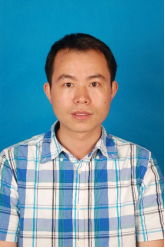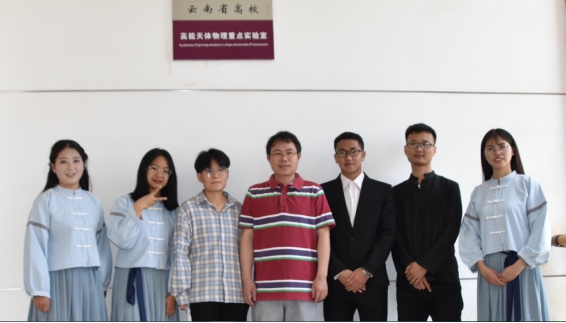
我是在2009年7月博士毕业后进入云南师范大学物理系,现担任天体物理学教授、云南省高校高能天体物理重点实验室主任。在这之前,我是从广西大学理学院物理系数理基地班本科毕业,在云南大学物理系攻读博士学位,曾在中科院云南天文台进行研究工作,也是广西相对论天体物理重点实验室的兼职研究人员。发表在国际学术期刊(SCI收录)上发表天文学及物理学方面的学术论文50余篇。两次获得云南省自然科学奖三等奖(排名第三和第四),两次获得云南师范大教学成果奖三等奖(排名第三和第一),获“红云园丁奖”二等奖。指导学生参加“挑战杯”、全国大学生物理实验竞赛等赛事,多次获得二等奖和三等奖。
我的研究小组目前(2023年)已毕业研究生7人(读博4人),在读研究生8人。我的研究小组每年招募本科生,研究生。如果您是对黑洞、星系和宇宙学感兴趣的本科生,并希望攻读硕士或博士学位,欢迎Email和我联系。
研究兴趣:
我对当代天文学的多个前沿领域都有广泛的兴趣,其中包括伽马射线暴、星系形成(恒星形成率),以及类星体(活动星系核)的光变(超大质量黑洞,黑洞吸积盘和喷流的准周期振荡)。
伽玛射线暴与类星体都是属于高能天体物理,同时也属于时域天文学领域,都依赖于国际上的大型巡天(时域巡天和光谱巡天)计划来提供观测数据。在这个两个研究领域,我们无法直接观测到伽玛射线暴或类星体的中心结构。类星体中心黑洞吸积盘及其“宽线区”的物理尺度很小,目前世界上最大的望远镜也无法分辨它们的结构特征,而光变曲线是当前唯一能够反映类星体内部的观测手段。
当前国际上最重要的时域巡天和光谱巡天项目包括:Fermi(satellite)-LAT伽马射线巡天(美国主导)、Swift(satellite)-BAT硬X射线巡天(美国主导)和卡特琳娜光学时域巡天、ASAS-SN光学暂现源巡天(美国俄克拉荷马大学主导),大视场地基广角望远镜(GWAC)暂现源巡天(国家天文台与广西大学主导)。云南师范大学大学与俄克拉荷马大学及广西大学有合作,因此可以获取后两个项目的观测数据,而前两个项目的数据是实时公开,我们研究小组已经编写了相关的数据处理软件,公开下载并处理这两颗卫星的数据,因此,我们小组在时域天文学领域有着得天独厚的优势。我们也使用欧文斯谷射电天文台(OVRO)、斯图尔特天文台耀变体观测项目、斯隆数字巡天项目的光谱及光变数据。各种巡天观测项目将在未来五年内提供更加丰富观测数据,我的研究团组将会在伽玛射线暴和类星体光变方向的积极参与“交叉相关、时间延迟、准周期震荡”(Cross-correlation, Time lag and Quasi-periodic Oscillation)等研究项目。我们将建立各种的随机统计模型来解释类星体光变曲线,将努力研究方法和模型并应用到最新的观测数据中,以期解释数据和限定模型参数。目前也参与了云南省中马HF-VHF先进射电天文技术国际联合实验室建设,与马来亚大学天文系有科研合作。
联系方式:云南省昆明市呈贡区聚贤街768号 云南师范大学物理与电子信息学院 天体物理中心
Address: Key Laboratory of Colleges and Universities in Yunnan Province for High-energy Astrophysics, Department of Physics, Yunnan Normal University, Kunming 650500, China
Email: You can always find me via yitingfeng98@163.com or 47315208@qq.com .
Curriculum Vitae (CV) of Ting-Feng Yi
I joined the Physics Department of Yunnan Normal University in July, 2009, Professor of Physics and Astronomy. Before that, I graduated from the Department of physics of Guangxi University, studied in Yunnan Observatory of Chinese Academy of Sciences and part-time researcher of Guangxi Key Laboratory for Relativistic Astrophysics.
My research group recruits undergraduates and postgraduates every day. If you are undergraduate interested in Astrophysics and Galaxy cosmology and want to study for a master's degree. Please contact me by email.
I have a wide range of interests in many frontier areas of contemporary astronomy, including gamma ray bursts, galaxy formation (star formation rate), and variabilities of quasars (active galactic nuclei) (supermassive black holes, accretion disks and quasi periodic oscillations of jet streams).
Gamma ray bursts and quasars are both high energy astrophysics and time domain astronomy. They all rely on the international large-scale sky survey (time-domain and spectral survey) programs to provide observation data. In these two research fields, we can’t directly observe the central structure of gamma ray storms or quasars. The physical scale of the accretion disk and its "wide line area" of the black hole in the center of quasars is very small. At present, the largest telescope in the world can’t distinguish their structural characteristics. The Light curve is the only observation method that can reflect the interior of quasars.
The most important time-domain and spectral survey projects in the world include Fermi (satellite) - lat gamma ray (led by the United States), swift (satellite) - bat hard X-ray (led by the United States), and Katrina Real Time Survey, ASAS-Sn optical transient source survey (led by the University of Oklahoma in the United States), Gwac is a transient source survey (led by the National Astronomical Observatories and Guangxi University). Yunnan Normal University has cooperation with Oklahoma University and Guangxi University, so we can obtain observation data of the latter two projects. The data from the first two projects is real-time public. Our research team has written relevant data processing software, and downloads and reduce the data of these two satellites at any time. Therefore, the data of the two satellites can be publicly downloaded and reduced at any time. Our group has a unique advantage in the field of time domain astronomy. We also use the spectral and optical data of the Owens Valley Radio Observatory (OVRO), Stewart Observatory's blazar observation project, and Sloan Digital Sky Survey Project. Various observation projects will provide more abundant observation data in the next five years. My research team will actively participate in the research projects, such as, cross correlation, time lag and quarter periodic oscillation in the research field of gamma ray storms and variability of Quasar. We will establish various stochastic statistical models to explain the light curves of quasars, and will study methods and models and apply them to the latest observation data, in order to explain the data and constrain the parameters of models. At present, we have also participated in the construction of the Yunnan Province China Malaysia HF-VHF Advanced Radio Astronomy Technology International Joint Laboratory, and have scientific research cooperation with the Astronomy Department of the University of Malaya.
Contact information: Astrophysics center, College of physics and electronic information, Yunnan Normal University, No. 768, Juxian street, Chenggong District, Kunming, Yunnan Province, China; yitingfeng98@163.com or yitingfeng@qq.com .

